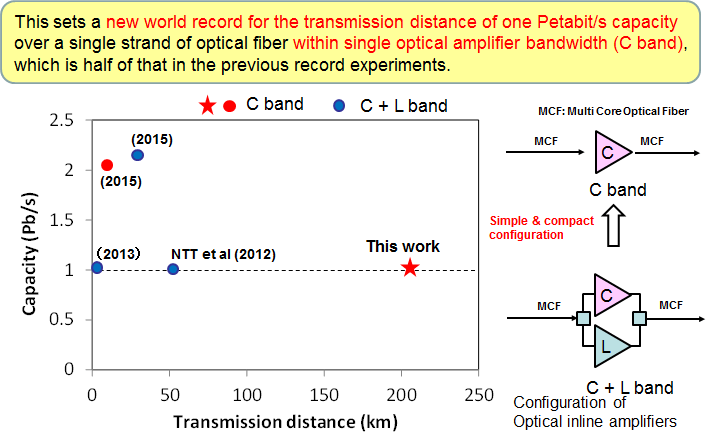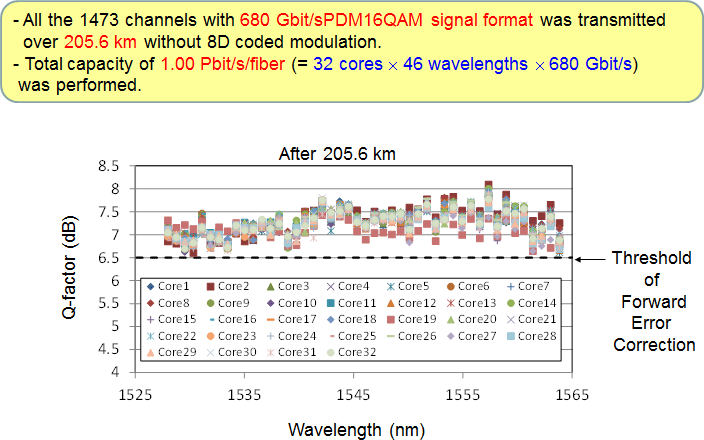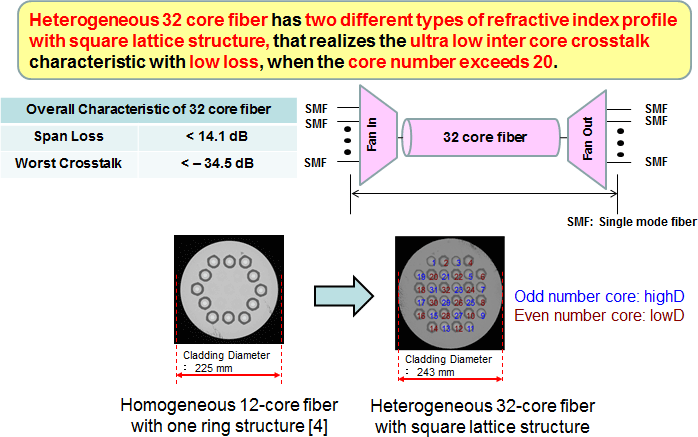Microsoft ends support for Internet Explorer on June 16, 2022.
We recommend using one of the browsers listed below.
- Microsoft Edge(Latest version)
- Mozilla Firefox(Latest version)
- Google Chrome(Latest version)
- Apple Safari(Latest version)
Please contact your browser provider for download and installation instructions.
March 23, 2017
One Petabit per Second Fiber Transmission over a Record Distance of 200 km - Paving the Way to Realizing the 1000 km Inline Optical Amplified Transmission Systems within C band only -
Nippon Telegraph and Telephone Corporation (NTT, Chiyoda-ku, Tokyo, President and CEO Hiroo Unoura) demonstrated ultra-large capacity inline optical amplified transmission of 1 petabit (1000 terabit) per second over a 205.6 km length of 32-core (light paths) optical fiber in collaboration with the Technical University of Denmark (DTU, Lyngby, Denmark, President Anders Overgaard Bjarklev), Fujikura Ltd. (Fujikura, Koto-ku, Tokyo, President and CEO Masahiko Ito), Hokkaido University (Hokkaido Univ., Sapporo, Hokkaido, President Keizo Yamaguchi), the University of Southampton (UOS, Southampton, UK, President and Vice-Chancellor Professor Sir Chris Snowden), and Coriant GmbH (COR, Munich, Germany, CEO Shaygan Kheradpir).
This sets a new world record for the transmission distance of one Pbit/s capacity over a single strand of optical fiber within a single optical amplifier bandwidth (C-band), which is half the bandwidth used in the previous experiment (Figure 1). The present achievement indicates that the transmission of one Pbit/s, a capacity equivalent to sending 5,000 HDTV videos of two hours in a single second, is potentially possible over 1000 km, which is approximately the distance between major cities both in Japan and in Europe. This remarkable achievement was reported as a post deadline paper*1 on March 23, 2017 at the Optical Fiber Communication Conference and Exhibition (OFC 2017), the largest annual conference on optical communication, which was held in Los Angeles, USA, from March 19 - 23, 2017.
Part of this research utilized results from the EU-Japan coordinated R&D project on "Scalable And Flexible optical Architecture for Reconfigurable Infrastructure (SAFARI)" http://www.ict-safari.eu/ commissioned by the Ministry of Internal Affairs and Communications (MIC) of Japan and EC Horizon 2020.
1.Background of the research
Along with the rapid advancement of broadband and cloud services resulting from the increased use of smartphones in recent years, communication traffic has been increasing at an annual rate of over 1.4 times (about 1000 times in 20 years), according to the statistics of the Ministry of Internal Affairs and Communications [1]. To cope with this rapid increase in communication traffic, we have so far been economically realizing high capacity optical networks by increasing the capacity of optical communication system equipment without changing the basic structure of the optical fiber already deployed. However, the physical capacity limit of the optical fiber used in current large capacity optical networks is estimated to be around 100 Tbit/s, which is only about ten times the current commercial capacity. If communication traffic is to increase at the same rate as it is now, we will reach the capacity limit with the existing optical fiber (Capacity Crunch) by the mid-2020s.
To realize a large capacity optical network capable of accommodating the expected increase in communication traffic long into the future, research and development of space-division multiplexing (SDM) optical communication technology*2 [2] using an optical fiber with new spatial structures such as a multi-core fiber (MCF) having multiple cores in one optical fiber is underway, attracting worldwide attention. NTT, Fujikura, Hokkaido University, DTU, UOS, and COR have been bringing together the technologies we each possess under joint academic and industrial collaboration, with the aim of realizing a large capacity optical network using SDM technology. We have been conducting research and development in the design and manufacturing technology of MCFs, and pushing the performance of the new fibers to the extreme limit.
2.Experiment and experimental results
By using the 32-core MCF, which we have successfully prototyped for a long length of over 50 km [3], fan-in/fan-out (FI/FO) device to couple light into the MCF, and by using a new digital coherent optical transmission technology, we have realized a high-capacity optical transmission rate of 1 Pbit/s. We achieved this by exploiting dense space and wavelength division multiplexing (DSDM and DWDM) over long-distance. The 32-core MCF used in the experiment utilized a new arrangement of cores that greatly reduces inter-core light leakage that otherwise degrades performance [3]. In addition, using the wave properties of light (phase*3 and polarization*4), we applied multi-dimensional coding*6 to polarization division multiplexed 16-quadrature amplitude modulation (PDM-16QAM) digital coherent technology*5 to improve the long-distance transmission performance in each core.
Figure 2 shows the experimental results. We realized 31.3 Tbit/s capacity per core (=680 Gbit/s per wavelength x 46 wavelength channels), and using the 32-core MCF, we recirculated and amplified the signals over four spans of the 51.4 km fiber, and showed that the signal transmission of an aggregate 1.00 Pbit/s capacity is possible over 205.6 km. Since the Q-factor, which shows the transmission quality of the PDM-16QAM signals, were uniform, it shows that high quality transmission with small variations between cores and low error is possible. Compared to the world-first 1 Pbit/s capacity experiment over 52.4 km that we reported in 2012 [4], we demonstrated about four times longer distance of 205.6 km, and is the world longest distance for over Pbit/s capacity transmission.
Moreover, by applying a digital signal processing technique called multi-dimensional coded modulation, the capacity per wavelength will be reduced by 25% to 510 Gbit/s, but we demonstrated that the transmission distance can be increased to over 1000 km. As a result, with one optical fiber, we showed that there is a possibility of the ultra-high capacity equivalent to 0.75 Pbit/s using just the 5 THz bandwidth of the C-band*7, and 1.5 Pbit/s using the 10 THz bandwidth provided by the combined C and L bands*7, with a potential transmission distance over 1000 km (Figure 4).
3.Technological features and roles
(1)32-core MCF transmission line (Figure 3)
The MCF we used in this experiment was jointly designed and prototyped by DTU, Fujikura, and Hokkaido University. The fiber has a new structure (single-mode heterogeneous-core MCF) with 32 cores incorporating several types of cores, each with different properties [3]. The characteristic of this fiber is that two kinds of cores with slightly different refractive indices are arranged in a square lattice pattern. With this structure, even if the number of cores is increased to 30 or more, the crosstalk between adjacent cores can be greatly reduced [3], and thus realize long-distance DSDM transmission [5]. NTT and COR have evaluated the long distance characteristics of the 51.4 km MCF transmission line with the 32-core MCF and FI/FO devices prototyped by Fujikura, UOS, and NTT. As a result, we confirmed that all cores had low crosstalk and low loss characteristics over the whole C-band, which is a requirement for a 32-core MCF transmission line suitable for transmission over 1000 km distance.
(2)Multi-dimensional coded 16 QAM technique (Figure 4)
In recent large-capacity optical communications, instead of the intensity modulation signal transmitted using binary states of either ON or OFF, a highly efficient PDM-QAM digital coherent signal*5 has been used that realizes a large number of signal states created by using the wave properties (phase and polarization) of the light. Such multi-level QAM signals can realize a highly efficient ultra-high speed optical signal by associating a plurality of bits of digital signals with a plurality of optical signal states encoded using the phase and polarization of light. However, the drawback is that when we increase transmission efficiency by increasing the number of multi-levels, the transmission distance sharply decreases. In addition, signal quality degrades by the crosstalk that arises in MCF transmission.
This time, NTT reduced the multi-level number of the QAM signal from 32 in the conventional report [4] to 16, and applied a wideband digital-analog conversion technique [6] to the digital coherent signal using a highly efficient error correction coding. As a result, we successfully transmitted a capacity of 680 Gbit/s per wavelength (1 Pbit/s per fiber) over a 205.6 km distance; the longest distance for a Pbit/s capacity transmission. Furthermore, by applying the 8-dimensional encoded 16-QAM technique [7] and by improving the allocation method of the digital signal and the optical signal state, the transmission quality can improve compared with the normal QAM code. With the same 16-level QAM, the transmission rate will be reduced to 510 Gbit/s per wavelength, but by doing this, we showed that it has the potential to extend the transmission distance to possibly over 1000 km.
4.Future Developments
The transmission distance of 1000 km, the possibility of which was proven in these experiments, corresponds to the distance needed to construct optical networks in Japan and in Europe, connecting major cities. In the future, we will promote cooperative experiments using multicore optical amplification technology [8] and network control techniques [9] in a testbed to be constructed at COR in Europe, and we will continue to support the development of broadband services for the realization of future long distance high capacity optical networks.
References
- [1]
http://www.soumu.go.jp/main_content/000462459.pdf
[2.12MB] (Japanese) - [2]T. Morioka, "New generation optical infrastructure technologies: "EXAT initiative" towards 2020 and beyond," 14th OptoElectronics and Communications Conference (OECC) 2009, paper FT4, 2009.
- [3]Y. Sasaki et al., "Crosstalk-Managed Heterogeneous Single-Mode 32-Core Fibre," European Conference on Optical Communication (ECOC) 2016, Paper W.2.B.2, 2016.
- [4]http://www.ntt.co.jp/news2012/1209e/120920a.html
- [5]T. Mizuno et al., "Long-Haul Dense Space-Division Multiplexed Transmission Over Low-Crosstalk Heterogeneous 32-Core Transmission Line Using a Partial Recirculating Loop System," J. Lightwave Technol., Special Issue on the Optical Fiber Communication Conference (OFC) 2016, vol. 35, no. 3, pp. 488-498, Feb. 1, 2017.
- [6]http://www.ntt.co.jp/news2016/1609e/160923b.html
- [7]M. Nakamura et al., "Coded 8-Dimensional QAM Technique Using Iterative Soft-Output Decoding and Its Demonstration in High Baud-Rate Transmission," J. Lightwave Technol., Special Issue on the European Conference on Optical Communication (ECOC) 2016, vol. 35, no.8, to be published in April 2017.
- [8]S. Jain, et al., "32-core Inline Multicore Fiber Amplifier for Dense Space Division Multiplexed Transmission Systems," European Conference on Optical Communication (ECOC) 2016, post deadline paper, Th.3.A.1, 2016.
- [9]Coriant Transcend™ SDN Solution, http://www.coriant.com/products/transcend-sdn.asp
.
Fig.1 The achievement in Petabit/s-class transmission

Fig.2 1Petabit/s - 205.6 km Transmission performance

Fig.3 Single-mode Heterogeneous 32-core fiber

Fig.4 Over-1000 km transmission by 8D-16QAM coded modulation

Glossary:
*1:Post deadline paper:
A paper accepted after the deadline for submitting general papers (post deadline). Research institutes in this field compete for the highest performance of optical communication technology with the latest technology just before the conference. Papers will be reviewed during the conference period and only the highly scored research paper will be presented.
*2:Space division multiplexing optical communication technology:
High-capacity optical communication technology to realize the optical transmission efficiency of higher than that of the conventional optical fiber having only one core. The technology utilizes the property of optical fibers having a new structure to the full extreme, such as a multicore fiber (MCF) using the spatial degree of freedom in an optical fiber, etc.
*3:Phase:
Light has wave-like properties just like radio waves do. The timing at which this wave oscillates is called the phase. Since the waves periodically oscillate, the phase has a degree of freedom from 0 to 360 degrees. By using this degree of freedom, we correlate the 1 and 0 of the digital data in different phases (for example 0 and 180 degrees). Detecting the phase difference at the receiving side, we can extend the transmission distance by high sensitivity reception, and can increase capacity by highly efficient communication, compared to the conventional communication using only ON and OFF.
*4:Polarization:
Light has two independent oscillation directions (X axis and Y axis) like radio waves do. This independent axis is called polarization, and 3D movies often use such properties to realize stereoscopic images by sending different information to the right and left eyes. In conventional optical communications, it was difficult to stably detect the orientation of the two polarized waves at the receiver side, so we could only use one of the polarization elements. With the digital coherent technology, since we can stably separate the two independent polarization directions at the receiver side, it became possible to communicate by corresponding independent information to each polarization, and realize efficient high capacity transmission.
*5:Polarization division multiplexed QAM (PDM-QAM) digital coherent technology:
In general, we use an intensity modulation technique that sends 0 and 1 of the signal in correspondence with the two states of intensity (ON and OFF). On the other hand, the PDM-QAM digital coherent technology, optical signals are modulated at multiple levels (independent I and Q components for each polarization). By modulating the signal with I and Q components with different multilevel signals, the electric field of each polarization generates multiple (N × N) signal states (quadrature amplitude modulation) with different intensity and phase. Highly-efficient and high-sensitive optical transmission is achieved by associating multiple bits (= 2 × log 2 N) of digital signals.
*6:Multi-dimensional Coded Modulation
When the multi-level number is increased to improve the transmission efficiency in the QAM modulation, the state of the optical signal (the combination of intensity and phase of the electric field) allocating the digital signal of multiple bits increases, and the equivalent distance between the optical signal states becomes close. This distance is called Euclidean distance. For this reason, a high signal-to-noise power ratio is required to discriminate the individual optical signal states, and the transmission distance is shortened due to the decrease in the receiver sensitivity. In multi-dimensional coded QAM modulation, in addition to the conventional QAM signal state (two independent directions of the optical electric field; I and Q components), we must consider the signal transition between the polarization axis and the time axis to expand the dimension. Here, the QAM signal is transmitted while not using the signal transition between the optical signal states where the Euclidean distance is close. As a result, when using the multi-dimensional coded QAM signal, the Euclidean distance can be taken longer, and the transmission distance can be extended compared to conventional QAM signals. The 8-dimensional 16-QAM signal applied in this experiment uses the optical signal state of the conventional 16-QAM signal. The transmission capacity will decrease by 25%, but it would be possible to transmit longer distance of about 4 times compared with conventional 16-QAM signal transmission.
*7:C-band, L-band
Standard optical communication wavelength band used for long-distance optical communication as a low-loss wavelength range for silica optical fiber, and is internationally standardized by the International Telecommunication Union - Telecommunication (ITU-T). The C (Conventional) band is 1530 to 1565 nm, and the L (Long wavelength) band is 1565 to 1625 nm. Practical optical amplification is possible with these two signal bands. When we convert each wavelength band to optical frequency bandwidth, it becomes about 4 to 5 THz, and when we combine the two bands, it becomes about 10 THz in the C and L bands.
Contact information
Nippon Telegraph and Telephone Corporation
Science and Core Technology Laboratory Group, Public Relations
a-info@lab.ntt.co.jp
Information is current as of the date of issue of the individual press release.
Please be advised that information may be outdated after that point.
NTT STORY
WEB media that thinks about the future with NTT











